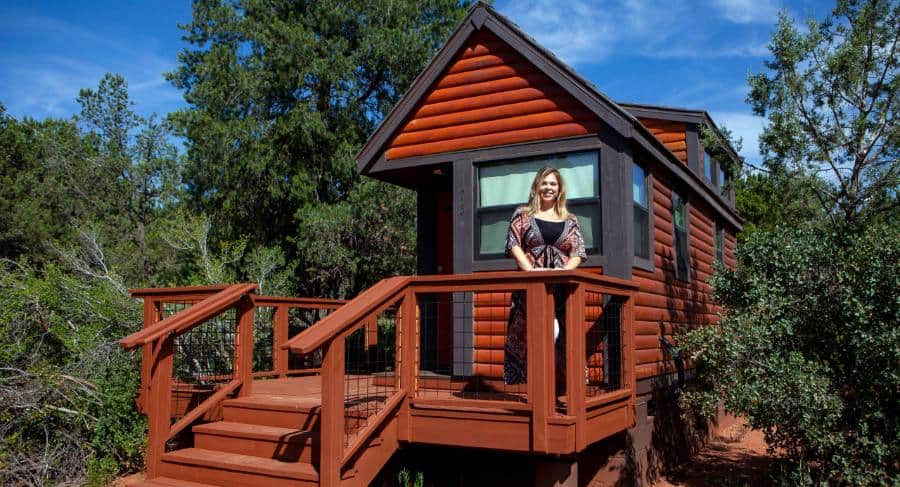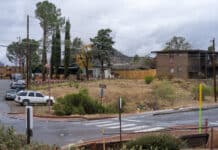It may still be too soon to determine if it’s a passing fad or something that’s here to stay.
In recent years the term “tiny houses” has been added to the vocabulary of many as some homeowners have chosen a simpler — and often less expensive — way of life. But in Sedona the trend hasn’t taken off despite sustainability and leaving a smaller footprint being a pair of important goals of many. However, that’s not to say the interest level is not there.
Steve Mertes, the city of Sedona’s chief building official, said when he started in the city two years ago he’d average at least eight inquiries a month into tiny houses. While that number has decreased slightly with time, he still has people asking about building individual homes or multiple ones.
“In the industry we never started thinking about tiny homes until we began seeing them on TV,” Mertes said. “What people see on TV is not always an IRC [International Residential Code] compliant home. Most of what you see on TV is what we call park models. Basically they’re an RV because they have a chassis and wheels. They’re not permanently installed.”
Currently, there’s nothing on the city’s books dealing specifically with tiny houses, which are defined as being 400 square feet or less in size. But that could change with the city council’s possible future adoption of the 2018 IRC, which includes an appendix dealing with tiny houses. Up until now, tiny homes were not addressed in the IRC.
If adopted by council, allowances and requirements within Sedona will include:
- The main egress door shall be no less than 32 inches wide.
- The minimum room dimension of a habitable room, other than the loft or kitchen, shall be 6 feet, 6 inches, and the room area shall be no less than 60 square feet.
- Tiny houses shall be built on, and permanently attached to full, contiguous concrete or masonry foundations.
- Tiny houses shall comply with other requirements of the adopted International Residential Code.
The only area within Sedona’s city limits zoned for RVs is the Rancho Sedona RV Park.
One can buy a tiny home and have it placed on a permanent foundation in Sedona as long as it meets city building standards and is manufactured by a company certified by the Arizona Department of Housing through its IRC program, Mertes said.
The only known tiny house in Sedona is one at the Sedona Charter School on Kachina Drive and is home to one of its staff members. That one was brought in from Texas about a year ago.
But that’s it so far.
“My own thought is that acquiring land in Sedona is a high cost and there’s still development fees and impact fee costs,” Mertes said. “So whether it’s a tiny home or not, you still have a lot of up-front costs. You then weigh the cost of a tiny home to that of building a 2,000-square-foot home. From what I have heard, depending upon the options you ask for, you can come very close to getting to the cost of building a typical-sized home.”
So why are they popular if the cost can often be nearly the same? As previously mentioned, Mertes said there are those considering sustainability and leaving a smaller footprint. While for others, it’s the appeal of being able to move the home when needed in those areas where it’s allowed or simply a desire to downsize their lifestyle. But the city has yet another reason of interest.
“We want to address our housing problem here and if people say we can do that with tiny homes, we want to make it easier for them to do so,” Mertes said.
A Look at Zoning
Sedona Senior Planner Carrie Meyer said from a zoning standpoint, the city would look at tiny houses in the same way they would at any other house. They would be allowed wherever a house is allowed, subject to building code standards. As for infrastructure, Meyer said a homeowner would have to provide all the necessary utilities such as water, sewer, electricity and gas to each unit. There would also be required parking for each unit, which is based on the number of bedrooms for multi-family projects and pay all applicable fees.
As for the number of tiny homes allowed on a parcel, she said that depends on where they’re proposing to go. Single-family zoning would allow one unit per lot, regardless of lot size. Multi-family zoning would permit whatever is allowed by the zoning. For example, RM-1 is eight units per acre, RM-2 is 12 units per acre and RM-3 allows 20 units per acre.
“In other zones, such as commercial or mixed use, the maximum density is 12 units per acre unless provisions are included to address local housing needs — availability and affordability — at which time we may be able to explore options for a higher density,” Meyer said.
She added that the updated Sedona Land Development Code includes a provision that smaller units count for less than a full unit when calculating density. Units under 1,000 square feet would count as 0.75 units and under 500 square feet count as 0.50 units.
“So, two tiny homes under 500 square feet would count as one unit for density purposes,” she said.
Coconino Welcomes Tiny Houses
Coconino County Community Development Director Jay Christelman said the county adopted a policy four years ago and since, it has approved a handful of permits, including ones in Oak Creek Canyon. The most popular request has come from those using them as an accessory dwelling unit on the same parcel as a primary residence. They are being used by family or college students.
He said they still get inquiries but what they’re seeing is, as Mertes mentioned, once people look at the cost, they often decide to build a normal-sized home.
“We saw the trend happening — along with the TV shows — so we wanted to get out ahead of it,” he said. “But it’s never gotten the traction that we had expected.”
A Practical Purpose
As noted above, Sedona Charter School is home to the only known tiny house in Sedona, on the Yavapai County side of the city. But it’s not by accident. The school’s director, Alice Madar, said with Arizona’s teacher shortage, they have to be nationally competitive to bring in teachers from out of the area and out of state.
“Even though we strive to offer competitive salaries and the best possible benefits, we found it difficult to attract teachers from out of the area because they could not find affordable housing,” she said. “We already had one teacher residence on site, and we know it has helped in retaining excellent teachers.”
Madar said they opted for a tiny house because it would have a small footprint. By installing a tiny house, they are leaving open the possibility of adding other small residences in the future. If the building had been larger it would have been difficult to do so.
“We do want to keep our property with an undeveloped feel, and the small cabin-type residence fits in with that,” she said. “It is cozy and has nearly everything a larger house would have.”






















